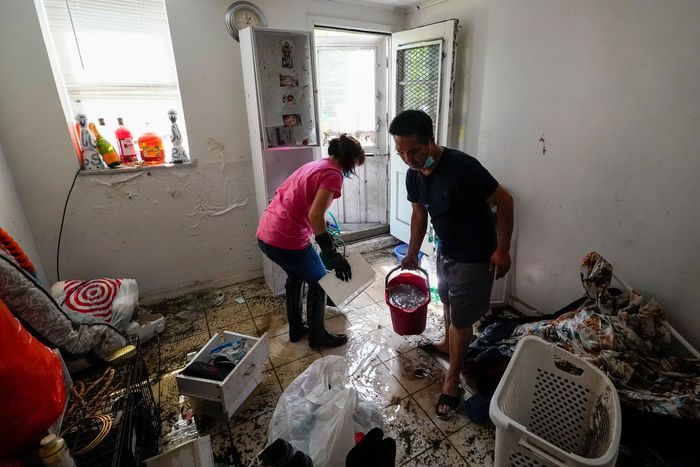
Nearly one year after a series of unprecedented deluges, two successive New York City mayors have proposed a variety of solutions to avoid more of the catastrophic basement-apartment flooding that killed 11 people last summer. In the past ten months, there has been very little large-scale action. As a stopgap, Eric Adams announced this week that the city is offering inflatable dams to 8,000 at-risk households at a total cost of $2.5 million. While it’s good to raise awareness ahead of hurricane season, says Deborah Helaine Morris, an urban-planning professor at Columbia and former executive director of resiliency planning at New York City’s Department of Housing Preservation and Development, offering a $43 off-the-shelf product won’t do enough to prevent more deaths and destruction — and in certain situations, it may actually make a flood worse.
One month out from hurricane season, the city has offered people inflatable dams intended to keep some water out of their houses. What’s your reaction to the announcement?
If the goal is to empower residents to have some ability to cope with climate change, I don’t think giving them deployable barriers is really a tool. A small percentage of people using an off-the-shelf product will have the time and ability and correct circumstances to use it to prevent damage to their property. For the majority, they’re not going to be in the right place at the right time, they’re not going to install it correctly, and it’s potentially going to create dangerous obstructions. With all these small redirections of water, people are going to redirect water onto their neighbor’s property. It will become so acrimonious. There will be very few blocks where every building owner deploys it in perfect lockstep.
It sounds like this won’t do much.
I don’t think it solves a problem. I think it is distracting from the broader challenge, which is a public-infrastructure problem. To empower people to deal with climate risks, you have to present them with different housing options that allow them to live in safer places. And that means more housing and certainly more consistent investment in public flood infrastructure.
The city’s plan at this stage is to send letters about a resident’s eligibility to receive a dam. Putting aside the products themselves for a moment, is there a more direct way to get people the support they’ll need in advance of flood season?
Say you have 25,000 of them in a warehouse. Just give them out. Tell people they can give it back if they don’t want it. Drop them at their doors if you have the list of places you want them to go. If there’s a particular place you think they’ll work, just give them to those people.
It seems there will be a learning curve here.
My parents live in eastern Queens, and they have a garage that’s below grade. They’re 80, they’re home all the time, they’re watching the news — if there was an alert that didn’t involve Twitter, they would get it. But I don’t think they would be able to set up a dam without help. Not everybody is a general contractor who understands how something like this prevents water risk; it has to really be in the right place or it’s not going to work. So you’re going to be trusting in something that won’t meet your needs, which will be upsetting and potentially dangerous — or it could cause more damage.
Are there other issues? If the city is sending out thousands of letters, they can’t be just in English.
The city sometimes does a really great job on language translation and sometimes totally misses it. But the bigger problem is whether people are capable of doing it. That’s not just a language issue; you’re asking people to take an infrastructure issue into their own hands. The whole reason we have shared infrastructure is that individual buildings can’t resolve those problems. I love New Yorkers, but we’re busy. And when you’re talking about protecting those working-class, stressed New Yorkers who are probably overcrowded in a one-to-four-family building, do you really think a deployable is going to help?
The rest of the mayor’s Rainfall Ready NYC plan is filled with the same kind of personal-responsibility language: check maps, clear drains. It heavily calls upon residents to shore up their own homes.
That would be fine if we lived in a place with a strong personal-responsibility identity like that. Maybe it would work in Germany or Japan. Catch basins get clogged by leaves, but they also get clogged by litter. So obviously, personal responsibility is inadequate. That’s why the government was created, to help us through disasters that can’t be solved by one person alone or even by individuals working independently.
It’s been nearly a year since 11 New Yorkers were drowned in their homes during Hurricane Ida. What more could the city have done between then and now?
A lot. It’s been a year. This is the real challenge for the city: figuring out a way to update its infrastructure and get people comfortable with the fact that the built environment and the way they live with climate risk are going to have to change. Your expectations of how you can live with respect to weather may have to adapt. In some places, that may mean fewer residents in buildings. In some neighborhoods, it may be that your street will look different to manage water. Even if there isn’t funding for this type of work, you can be building that momentum for a city that’s actually built to deal with rain risks and extreme weather patterns. That’s big. And that’s something a mayor can do.




